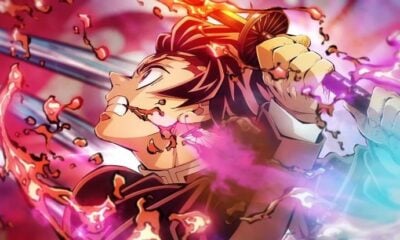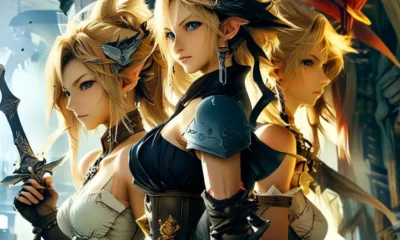Features
Not so Final Fantasy – Summons and Mythology
Not so Final Fantasy is a new, triweekly column dedicated to all things Final Fantasy; from specific aspects of specific titles, to the universal features that set Square Enix’s inimitable JRPG series apart from the rest.
Summons, Espers, Eidolons, Aeons, Guardian Forces, Primals, or Astrals: whatever you prefer to call them, Final Fantasy’s lavish roster of formidable beasts and mighty demi-Gods is one of the most recognizable aspects of the entire series.
Introduced in Final Fantasy III – the third installment of the series, not the erroneously numbered North American port of Final Fantasy VI – they’ve been getting us out of trouble ever since; obliterating fearsome enemies with their spectacular signature attacks and generally helping us rescue victory from the jaws of defeat.
However, although it would be easy for me to wax lyrical about the summon attacks themselves, for the inaugural edition of ‘Not so Final Fantasy’, I want to discuss the real-world myths and legends that inspired 5 of the series’ most recognizable summons in the first place. Starting with…
Bahamut
Despite the fact summons didn’t appear in their traditional guise until FF III, everyone’s favorite video game dragon, Bahamut, is actually as old as the series itself.
In the original Final Fantasy, king Bahamut, as he was then known, serves as a rather important NPC who, just over halfway through the adventure, grants the Warriors of Light access to upgraded, more powerful versions of their initial character classes, enabling them to defeat the game’s big bad, Garland. And it wouldn’t be the last time Bahamut played a larger role in a Final Fantasy narrative than his brethren.
However, since guiding the Warriors of Light to victory in 1987, his primary function has, like the rest, been as a summonable ally; albeit one of the most powerful in whatever game he appears, due chiefly to the potency of his non-elemental, defense-ignoring Megaflare attack.
But where does Bahamut come from, I hear no one ask? Well, rather interestingly, Bahamut’s physical appearance – a colossal, usually black-scaled dragon with piercing eyes and an undeniably regal demeanor – and characteristics, appear to derive more from early versions of Dungeons and Dragons than real-world mythological tradition.
For starters, in D&D, Bahamut is actually a dragon; the king of the draconids, to be precise, and the counterpart of another Final Fantasy mainstay, Tiamat. Whereas, in pre-Islamic Arabian tradition Bahamut (also spelled Bahamoot and sometimes called Balhut) is depicted as an unimaginably large fish/whale-type creature on whose back sits the cosmic bull named Kuyutha (or Kujata) who, in turn, supports the equally colossal Angel on which rests the Earth, the 7 heavens, and the 6 hells. The core of the Russian doll of creation, if you will.
That being said, the Bahamut that appears in Dungeons and Dragons bears more than a passing resemblance to another, competing Arabic tradition in which he is indeed a dragon, rather than an ocean-sized fish, who himself rides a vast whale named Liwash.
It would seem, then, Final Fantasy’s version of Bahamut could well owe a debt of gratitude to Eastern mythology after all.
Ifrit
Like so many of the summons we’ve come to know and love over the years, Ifrit’s debut appearance was in Final Fantasy III.
A demonic Djinn with a pair of long, menacing horns in the early days and a predilection for fire, Ifrit is usually one of the first summons the party encounters during their adventure. As such, he rarely competes with Bahamut in terms of power and versatility. However, like the aforementioned dragon King, he too originates in Arabian mythology.
In Islamic tradition, Ifrits are a class of Djinn who, along with Humans and Angels, are one of God’s 3 sentient creations; more specifically, they are a race of infernal spirits associated with death who seek retribution for murder victims. Crucially, they can be both good or evil, depending on the individual, which could account for the wildly different portrayals of the summon Ifrit throughout the series: the warmongering, pitiless general of FFXI, the man-hating God of FFXV, the twin’s kind-hearted if gruff-looking companion in World of Final Fantasy etc. etc.
He has become gradually more bestial as the series has progressed, however, while he might have departed from the original concept in that regard, he’s always retained the connection to fire that seems to be a fundamental part of the traditional Ifrits, who were said to dwell in the underworld, be capable of taking on the form of Satan, and had scorching hot flames leaping from their mouths.
Leviathan
Just like Bahamut, Leviathan’s debut pre-dates the introduction of the series’ iconic summon mechanic, although Leviathan’s first appearance wasn’t in the original Final Fantasy; it was as the colossal sea serpent who swallows the party’s ship in Final Fantasy II.
Remaining largely unchanged in appearance ever since – apart from Final Fantasy: The 4 Heroes of Light in which she’s portrayed as a squid-like monster with serpents for tentacles – Leviathan’s exact origins are nonetheless rather difficult to pin down for the simple fact there are so many unrelated, yet strikingly similar, legends across the globe that could rightly claim to form the basis of the Final Fantasy version.
The closest analogue is probably Ryujin/Owatatsumi no Kami. In Shinto legend, Ryujin was a dragon God that ruled the seas and tides, characteristics that are closely mirrored in various Final Fantasy games, the most obvious of which being the benign guardian that protects Wutai in FFVII.
Close as this parallel might seem, however, the mythological Leviathan appears frequently in Hebrew tradition too. Now, admittedly, she’s not always portrayed as a sea serpent, but in the main, the Hebrew Leviathan is described as a sea-dwelling creature of immense size and, in Judaic tradition, Leviathan is female; a common feature throughout the series.
There are various other myths and legends that might have influenced Leviathan’s initial design: the gatekeeper of hell, demonic prince of the underworld, and physical manifestation of envy in Christian mythological tradition; the Mesopotamian Tiamat legend; the biblical whale that swallowed Jonah; and Jörmungandr, the world serpent of Norse mythology.
Although, as none of these bear much more than a passing, superficial resemblance to Final Fantasy’s Leviathan, my money’s on Judaic tradition or the Ryujin legend.
Ramuh
Surprisingly, when you consider he’s been around since Final Fantasy III, Ramuh hasn’t been a permanent fixture.
In FFVIII and X, he was replaced by Quetzalcoatl and Ixion respectively who, though perfectly adequate additions to the pantheon of Final Fantasy summons, simply didn’t have the same aura and appeal as the wise, staff-wielding, lightning-throwing ancient who’s accompanied us on so many adventures over the years.
After all, when he’s not electrocuting enemies with his Judgement Bolt attack, he often provides the party with plot-crucial advice. It’s Ramuh, for instance, who informs protagonist Terra of her parentage in FFVI, while in IX, he’s the first Eidolon to lend Garnet his support after her powers have been stolen by Zorn and Thorn. He’s even one of the 6 divine Guardians of Eos in FFXV.
His origins are similarly patchy. Indeed, more so than any other on this list, Final Fantasy’s Ramuh appears to be a composite of various myths and legends from around the world.
Firstly, his connection to thunder and lightning most closely mirrors Indra, the king of the Devas in Hindu mythology and the God of rain, lightning, and storms, while conversely, his appearance is purportedly inspired by the Mesopotamian God Lahmu – a beneficent deity characterized by his flowing white beard and red sash.
Meanwhile, his sagacious and judicious personality has been compared to the priest king Ra-mu who, according to legend, ruled the fictional sunken continent of Mu and his name, if not a simple adaptation of Ra-mu, could well be a mixture of Lahmu and the Hebrew word Ra’am, meaning ‘Thunder’, or perhaps Rama; hero of the Hindu poem The Ramayana and the seventh avatar of the God Vishnu.
Whatever Ramuh’s true origins are, it’s clear Square did its homework when it was looking for a Thunder-elemental summon in 1990. I just wonder why they didn’t choose Thor? Oh well.
Shiva
A blue-skinned, scantily-clad, ice goddess, Shiva, has been freezing monsters to death with her Diamond Dust attack since, you guessed it, Final Fantasy III. And providing a certain amount of virtual titillation for an entire generation of teenage gamers, of course.
Now, given her name, you might think Shiva is based on the Hindu God of the same name: I certainly did when I was introduced to the series 20 years ago. However, the Final Fantasy version shares little in common with traditional Hindu mythology in which Shiva the destroyer is a primarily male deity who only adopts female characteristics when merged with consort Pavarti (forming the androgynous God of Duality, Ardhanari), and, more importantly, is an integral part of the Hindu Triad along with Vishnu and Brahma, not the God of ice or snow.
For these reasons, some speculate Final Fantasy’s portrayal of Shiva is based primarily on Shaktism Hindu tradition and one very specific aspect of the standard Shiva myth. You see, in Shaktism mythology, life is fundamentally feminine in nature, including deities, explaining why she’s portrayed as unambiguously female throughout the Final Fantasy series. While more traditional Hindu legend, which identifies the frigid Mount Kailash/Kail?sa as Shiva’s abode, accounts for the elemental attributes that distinguish Shiva from her fellow summons.
Not that the Final Fantasy Shiva’s origins are definitely Hindu. An alternative theory suggests the relatively obscure Slavic fertility Goddess Ziva might have inspired certain aspects of the character; specifically her sultry, voluptuous appearance, which would conform with Slavic depictions of the Goddess as habitually nude.
But perhaps it’s safer to assume Shiva is simply yet another composite creation that demonstrates just how varied Square’s sources of inspiration were when it was designing these interesting and unique characters.
That’s about it for this week’s article. Hopefully it was at least mildly distracting if not entirely educational – I’m sure plenty of Final Fantasy fanatics were already perfectly familiar with the mythological backgrounds of this particular quintet; especially if they’ve spent any length of time looking through the archives of the Final Fantasy Wiki in the past.
Either way, check back in 3 weeks’ time for another edition, if you’re so inclined, when the topic of discussion will be Final Fantasy IV’s Cecil and whether or not he deserves his status as the series’ greatest protagonist.

-

 Features4 weeks ago
Features4 weeks agoDon’t Watch These 5 Fantasy Anime… Unless You Want to Be Obsessed
-

 Culture3 weeks ago
Culture3 weeks agoMultiplayer Online Gaming Communities Connect Players Across International Borders
-

 Features4 weeks ago
Features4 weeks ago“Even if it’s used a little, it’s fine”: Demon Slayer Star Shrugs Off AI Threat
-

 Features2 weeks ago
Features2 weeks agoBest Cross-Platform Games for PC, PS5, Xbox, and Switch
-

 Game Reviews4 weeks ago
Game Reviews4 weeks agoHow Overcooked! 2 Made Ruining Friendships Fun
-

 Features2 weeks ago
Features2 weeks agoThe End Is Near! Demon Slayer’s Final Arc Trailer Hints at a Battle of Legends
-

 Features3 weeks ago
Features3 weeks ago8 Video Games That Gradually Get Harder
-

 Features3 weeks ago
Features3 weeks agoDon’t Miss This: Tokyo Revengers’ ‘Three Titans’ Arc Is What Fans Have Waited For!
-

 Game Reviews4 weeks ago
Game Reviews4 weeks agoHow Persona 5 Royal Critiques the Cult of Success
-

 Guides3 weeks ago
Guides3 weeks agoHow to buy games on Steam without a credit card
-

 Game Reviews2 weeks ago
Game Reviews2 weeks agoFinal Fantasy VII Rebirth Review: A Worthy Successor?
-

 Uncategorized3 weeks ago
Uncategorized3 weeks agoSleep Meditation Music: The Key to Unwinding
























